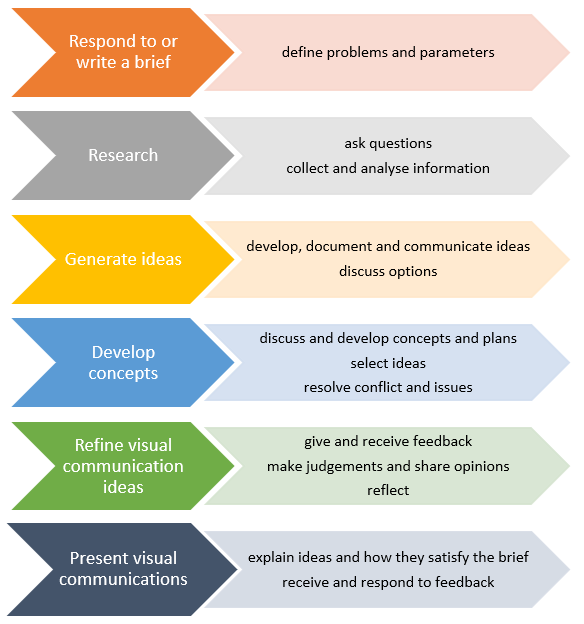This section is focused on literacy in Visual Communication Design (VCD).
The information and resources address the reading and viewing, writing, and creating and speaking and listening modes across the VCD curriculum.
Literacy in Visual Communication Design (VCD)
Visual Communication Design (VCD) relates to the purposeful creation and use of visual language to create meaning. Literacy in VCD thus requires students to develop an understanding of visual and multimodal literacies and how to effectively communicate ideas, whether through images or written or spoken language.
Generally, then, literacy in VCD refers to the literate practices and strategies that enable individuals to
- access, identify and understand elements of designed communications
- analyse and evaluate designed communications
- communicate ideas through the purposeful design of visual images and multimodal texts, including written and spoken language
- analyse and evaluate VCD knowledge, practices, processes, and technologies.
Literate demands in Visual Communication Design education
In VCD, students must implement a range of literacy skills to
- develop ideas
- interpret briefs
- understand the design process
- use writing skills to construct analyses of a range of visual communication outputs
- develop specific oral language skills to articulate ideas and persuade audiences.
VCD students use discipline-specific terminology related to design elements and design principles. There is some crossover in terminology between the elements and principles used in the other Arts areas. However, in VCD, some terms are specific to three key fields:
- communication design: design relating to graphics, information, digital and print texts, websites, advertising, logos, and brand identity
- industrial design: design relating to products and furniture
- environmental design: design relating to internal and external environments, such as architecture, interior design, landscaping, set design and exhibitions (VCAA, 2016, p. 12)
Additionally, visual communications are increasingly inter-and multi-cultural, multi-textual, multi-meaning and multi-modal. In other words, designed communications are complex as they have multiple layers of meaning. Explicitly teaching students about the ways to read, observe, see, decode, reconstruct and know about the world through production, presentation and consumption (Harris, 2006) in VCD assists them to build capacity for critically engaging as visual designers and audience.
Thus, the literate demands in VCD include:
- developing visual, digital, and multimodal literacies
- creating and presenting VCD-specific written and oral texts, including design briefs and 'pitches'
- applying design elements and principles, and exploring media, materials, and methods in their own design
- thinking and responding creatively, critically, and reflectively.
Students in VCD engage with and produce a range of texts, including:
- annotations of design elements and principles
- manual and digital drawings to represent form, materials and surface textures
- design briefs that identify and meet specific audience needs
- oral presentations, including 'pitches,' that explain and justify visual communication designs for specific audiences and purposes.
- oral and written feedback and reflection.
Finally, design thinking, and the design framework underpin the overarching process that informs both student-produced work and the interpretation of other designers' work. Each stage of the design process has a unique set of literate demands.

Literacy in the Victorian Curriculum: Visual Communication Design
Literacy and understanding how meaning is conveyed visually and fundamental to Visual Communication Design. This is reflected in the Victorian Curriculum 7-10: VCD, which aims to:
- communicate ideas and information in creative and innovative ways
- apply design elements and principles, to create, explore and analyse visual communications
- apply visual design thinking skills to create, critique and reflect on designed communications
- understand how cultural contexts impact visual communication design (VCAA, n.d.).
These aims are reiterated in the four strands of the curriculum:
- Explore and represent ideas: students explore and experiment with ideas for designed communications for different audiences and purposes.
- Visual communication design practices: students develop and refine their understanding, skills, techniques, technologies, and processes relating to VCD
- Present and perform: students develop and refine visual communications for different audiences and purposes, and consider the relationship between the designer’s intentions, the audience characteristics, and needs.
- Respond and interpret: students analyse and evaluate designed communications for different audiences and purposes in different contexts (VCAA, n.d.).
References